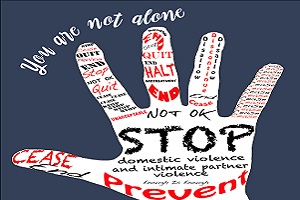
Safety and Privacy Alert: If you are viewing this, you may wish to maintain your privacy on the internet. Any use of the internet leaves a trail – this site is no different. Learn how to ensure your privacy.
The following resources and tools are provided to assist City supervisors in addressing domestic/intimate partner violence in City workplaces. At any time, when you feel that these resources are not sufficient to address your needs or if you are unsure how to proceed (e.g. whether or not to have police involvement, what should be included in the safety plan), contact Corporate Security or EAP for consultation. If you feel your workplace is at imminent risk, call the police.

“If an employer becomes aware, or ought reasonably to be aware, that domestic violence that would likely expose a worker to physical injury may occur in the workplace, the employer shall take every precaution reasonable in the circumstances for the protection of the worker.“
Sources:

In addition to the abused person, domestic/intimate partner violence affects co-workers and the work environment. The effects can range from subtle to dramatic. As a supervisor or manager, it is important to be aware of potential problems.
Domestic violence is absolutely a workplace issue. When [a partner leaves the] abuser, where is the one place the abuser knows the [partner] will be every day? Work.
Cambridge Domestic Violence Advocate
Sources:

Domestic/intimate partner violence can occur in all cultures and communities. While it can be difficult to recognize, there are many signs that might indicate an employee is experiencing domestic/intimate partner violence. Being aware of potential signs of domestic/intimate partner violence can help you to take appropriate measures to prevent it from escalating in your workplace. You may notice that your employee is less productive than usual or see changes in social behaviour. Some visible signs of abuse might indicate an escalation of violence that could enter a workplace.
Your employee is:
Your employee is:
Your employee is:
Sources:

Domestic/intimate partner violence thrives when abused partners are isolated and many cultures have promoted a “mind your own business” attitude. Many of us learned to be hesitant about becoming involved in situations of domestic/intimate partner violence. Here are other ways of looking at some common concerns:
Table 1. Points of Concern and Points to Consider.
| Points of Concern | Points to Consider |
|---|---|
|
|
|
|
|
|
|
|
|
|
|
|
Open discussions about domestic/intimate partner violence decrease the risk for everyone in the workplace. If your employees feel comfortable bringing forward information about potential threats or violent behaviour, then both employers and co-workers will be better prepared to recognize potential risks and prevent a workplace incident.
In a healthy workplace where difficult topics can be discussed, people are more likely to notice when a co-worker is in distress and a person experiencing domestic/intimate partner violence can more safely disclose their situation. Have open discussions with your employees to improve workplace safety.
Be aware that an employee may choose not to disclose information about domestic/intimate partner violence during a first discussion. If this is the case, inform the employee that if they would like to discuss any matters that might be affecting them in the future, either yourself or a nominated contact is available to provide support.
Sources:
Above is a video from WorkSafeBC on talking to an employee who might be experiencing domestic/intimate partner violence. A video transcript (pdf) is available for download.
Talking about domestic/intimate partner violence can be difficult. Bringing up personal issues with an employee can be uncomfortable and you may feel frustrated if an employee doesn’t want to take action. When you handle these concerns genuinely, it is a starting point for increasing safety in the workplace and providing support. Remember that is it not your role to be a therapist or to ‘fix’ the situation. Reaching out, showing concern and offering support can make a big difference.
These are some tips for speaking to an abused person, as well as some reminders to help you deal with frustration.
Since it can be difficult to identify someone experiencing domestic/intimate partner violence, approach conversations with caution. Remember to bring up domestic/intimate partner violence only in a safe and private environment.
You can start a conversation with statements such as:
You could ask:
You are encouraged to be mindful of the type of language that you use when talking to employees and to avoid labelling them, using terms the employees don’t identify with (e.g. victim).
When talking to your employee, do NOT say things like:
These statements might make employees experiencing domestic/intimate partner violence feel like you don’t believe them or that you are blaming them for allowing their situation to continue. If someone thinks you don’t believe them or their situation isn’t serious, it could cause them to withdraw and not confide in you again. Furthermore, experts advise that those who experience domestic/intimate partner violence should not be encouraged to leave a relationship before they feel ready and have assessed that it is safe.
If the employee discloses abuse, show that you are supportive, remain non-judgemental when you ask questions, be clear and be sensitive.
Believe your employee and be supportive. Acknowledge the courage it takes to talk about domestic/intimate partner violence and reassure the employee that they have done the right thing by coming forward. Make sure the employee knows that this will not reflect badly on his/her work:
Listen carefully. The person knows more about their situation than anyone else. Respect the employee’s suggestions, needs and choices:
Express understanding. Tell the employee that you know sometimes “personal issues” can spill over into the workplace or interfere with work performance:
Tell the employee it is not his/her fault:
Validate the employee’s feelings. The employee may feel hurt, angry, afraid, ashamed or trapped. They may love the abuser and think that the abuser can change:
Focus on safety. Assess the situation and invite the employee to participate in creating a personal safety plan for her/his time at work. The employee should also be encouraged to:
As well, ask open-ended questions about changes, if any, which could be made in the workplace to make the employee feel safer. For example, arranging a schedule that is less predictable might protect the employee from harassment by an abuser who knows their current patterns. This might mean offering a flexible schedule, different shifts, or other work arrangements. Identify opportunities for time away from work to make it easier for them to get help and to rebuild their life.
Consider the children (if any). If children are involved in domestic/intimate partner violence and there are concerns for their safety because of violence in the home, the law is clear that you must contact the Children’s Aid Society in your community immediately. Explain to the employee that this is your legal obligation.
Maintain confidentiality. Remember to keep the information confidential. If there is a threat to the workplace, tell your employee that you will only share the information on a need-to-know basis. If you do need to share information, a more empowering approach is to tell your employee that you will try to do it when they are present, or ideally allow them to share the information.
Other factors to remember:
If the employee chooses not to disclose abuse, but you still have reason to believe it is a concern, do not push the employee. Tell them that you are still going to be there anytime they want help. Consider that the employee may be afraid or not ready to take the next steps. Very often, even though it may not seem so to us, the abused person knows what timing and action is best for themselves.
Remind the employee of any services that the workplace offers, such the Employee Assistance Program, and/or direct the employee to external resources.
Helping someone experiencing domestic/intimate partner violence can be difficult and frustrating. They may not explore the options you suggest, which could cause you to experience “compassion fatigue.” Remember that domestic/intimate partner violence involves the perpetrator controlling the person and taking away her/his power. It can therefore be difficult for someone suffering abuse to leave the relationship.
There are many reasons why those experiencing domestic/intimate partner violence sometimes stay with their abusive partners, including:
Domestic/intimate partner violence can be a gradual process and it may take years for the abused person to realize it will never stop. If you become frustrated while trying to help an employee who is experiencing domestic/intimate partner violence, remember that it can take time for someone who has experienced abuse to feel empowered. Your support is important and can make a real difference.
Sources:

There may be situations in which both the abused partner and the perpetrator of domestic/intimate partner violence are your employees. If you feel unsafe starting a conversation with someone perpetrating violence, contact a professional for help. Safety is your primary concern and you should not put yourself or anyone else in your organization in a situation that seems unsafe.
You may become aware that an employee is using work hours and/or equipment such as telephones and emails to harass a partner. If your employee makes threats or commits acts of violence in the workplace, it is important to take immediate action. First, take steps to ensure the safety of the workplace. Review the safety planning section of the site for suggestions on how to handle a situation when two employees are involved in a domestic violence situation with each other.
Be alert to the possibility of domestic violence if you hear the following:
If a suspected perpetrator presents a problem such as drinking, stress or depression, but does not refer to any abusive behaviour, these are useful questions to ask:
If there is further indication that domestic/intimate partner violence may be an issue, other useful questions to ask include:
If your employee confides or confirms that they are being violent at home, or you otherwise become aware that your employee is abusing a partner, you might try the following:
Consult with Legal and/or Employee and Labour Relations, as required.
You can open a conversation by saying things such as:
Keep the personal safety of yourself and your employees’ top of mind and do not physically intervene in a violent situation or try to mediate relationship issues.
All people engaging with perpetrators should adopt the following constructive good practice responses:
Sources:

If employees disclose that they are experiencing domestic/intimate partner violence, there are a number of items to consider when responding:
Believe, reassure and support. It can be extremely difficult to disclose domestic/intimate partner violence. Believe the employee and do not ask for proof.
Disclosure of unlawful activity/serious offence. If you believe there is reasonable cause to suspect a person has committed a serious offence, then you should report this to the appropriate authorities. Protection for children and vulnerable adults – someone who may be in need of community care services by reasons of mental health, disability, age or other illness that renders them vulnerable to harm or exploitation.
Risk assessment. Following the disclosure of domestic/intimate partner violence, you should undertake a workplace risk assessment to ensure any potential risk to the employee and work colleagues are addressed and minimized.
Perceived risk to colleagues. If there is a perceived safety risk to work colleagues, you may consider it necessary to inform other employees so that they can take appropriate precautions. If this is the case, then you should advise the employee and agree on the best way to approach this. Ensure that the information shared is on a need-to-know basis and remind colleagues about the importance of confidentiality.
Safety planning. Work with the organization specialists (i.e. EAP, Security, Human Resources) and the employee to create and implement a workplace safety plan.
Internal and external sources of support. The workplace may be the only place where an abuser is unable to closely monitor their partner, unless both parties are employed by the same workplace, making it a good place for the abused person to access information and advice. Provide the employee with resources for support. Note: A referral to any form of “couples” or “joint family” counselling is inappropriate and unsafe when domestic/intimate partner violence is a risk.
Internal support. Explore leave options (while maintaining contact) and flexible work hours for the employee if the employee requires time off to sort out practical and legal issues such as counselling, visits to police/solicitor/court/support agency/housing/childcare, etc. If a leave option is selected, ensure you plan the employee’s return to work with them. Adjust performance targets and workloads. Where appropriate, arrange for wages to be paid in cash, into a different bank account, etc.
While this may be frustrating, remember that it is their choice – they have the right to refuse or reject support and assistance. Do not become angry with an employee or show “disapproval.” Be clear that the organization is concerned about the employee’s safety and that they can still approach anyone in the organization for support and assistance if they change their mind. Give the employee information about who they can contact, now and in the future.
In the event that the perpetrator also works in the organization, this needs to be addressed.
Responding to perpetrators and showing your workforce that you will do so sends an important message. It is also an important and positive message to impart to those who are abused as it lets them know that others will take action about domestic/intimate partner violence.
Engaging with perpetrators of abuse in a positive, respectful way does not mean excusing the abuse. Employers have a duty of care towards their employees. This includes perpetrators of domestic/intimate partner violence, who, through their actions, are damaging their own lives as well as the lives of others.
Remember, if you feel unsafe starting a conversation with someone perpetrating violence, contact a professional for help. Safety is your primary concern and you should not put yourself or anyone else in your organization in a situation that seems unsafe.
Some items to consider when responding include:
Minimization and denial. Some perpetrators – even when they have sought help voluntarily – are unlikely to disclose the seriousness or extent of their abuse. They may try to “explain” or blame it on other people or external factors. Other factors may also present problems, such as alcohol, stress or depression, and the perpetrator may not refer directly to the abuse as the problem.
The nature of the conduct and the nature of the employee’s work. Where appropriate, you may need to take action to minimize the potential for perpetrators to use their position or work resources to find out details about the whereabouts of his/her partner. This may include a change of duties or withdrawing access to certain computer programs.
Risk to other employees and the general public. You may believe there is a conflict between the offence and the job that the employee is employed to do. In some cases, the fact that an employee is a perpetrator may make certain duties inappropriate and justify redeployment/disciplinary action. For example, it would be inappropriate for a perpetrator of domestic violence to be providing advice to vulnerable women and children and/or the public.
Domestic/intimate partner violence has complex impacts on the abused person. It is important to remember that your approach to domestic violence should be a supervisory/managerial commitment through which you suggest solutions within the sphere of your control and expertise. It is vital that additional specialists within the organization, such as Employee Assistance Program, are brought in and that employees disclosing domestic/intimate partner violence are made aware of additional internal and external sources of support.
It is advisable to make comprehensive notes to retain detailed records if an employee discloses domestic/intimate partner violence. Any discussions about domestic/intimate partner violence and any actions agreed upon should be documented to provide as full a picture as possible.
It should be made clear that recording domestic/intimate partner violence will have no adverse impact on the employee’s employment record. You should record all absences in accordance with normal procedures, but if they relate to domestic/intimate partner violence, then they can be placed in a sealed envelope within the employee’s file marked “for manager and employee’s access only.”
Remember that you have a duty to maintain a safe workplace and this necessitates monitoring and recording all incidents of violence or threatening behaviour in the workplace. These may also include persistent telephone calls, emails, visits to the workplace by the perpetrator, etc.
This information can be used if the employee elects to press charges, or applies for an injunction or a court order. The organization could assist the employee to apply for an injunction if the actions of an alleged perpetrator affect the health and safety of the employee. Witnesses to such incidents should also be recorded.
Source:
Above is a video from WorkSafeBC on developing a workplace safety plan. A video transcript (pdf) is available for download.
Make It Our Business provides a generic sample safety plan, available for download.
As a supervisor, you are not expected to be an expert in domestic/intimate partner violence. However, you are responsible for protecting the health and safety of workers in the workplace, as well as for providing support to those you supervise. There are things you can do to support the workers in your workplace and to reduce the likelihood that domestic violence will compromise the health and safety of all workers, including the person experiencing domestic/intimate partner violence:
A workplace safety plan and/or a personal safety plan might be needed for addressing domestic/intimate partner violence in the workplace.
A workplace safety plan sets out specific actions that will be taken to help keep the workplace and all workers safe from threats of domestic/intimate partner violence.
A personal safety plan is designed to keep a specific employee who is experiencing domestic/intimate partner violence safe while at work. A personal safety plan will depend on the individual’s specific situation. Preferably it will be developed in consultation with the employee and tailored to their self-identified needs, keeping the overall safety of the workplace in mind.
Examples of actions that may be included in safety plans are identified below. Not all of these suggestions will be appropriate in all circumstances. In consultation with the employee who is experiencing domestic/intimate partner violence, you may also identify safety plan components that are not on these lists. Consultation with Corporate Security and the EAP may also assist in identifying other appropriate interventions.
A Workplace Safety Plan might include the following prevention steps:
Note: Some of these may already be in place to protect against all forms of workplace violence
A personal safety plan might include the following:
You may be faced with a situation in which two employees are involved in a domestic/intimate partner violence situation with each other. This can be a highly volatile situation. If two employees are involved in a domestic/intimate partner violence situation with each other, appropriate action may include:
Sources:



Domestic/Intimate Partner Violence Poster
To raise awareness of this issue, please print and post this in your workplace.

Webinars
Make It Our Business provides a series of webinar recordings and related resources.


